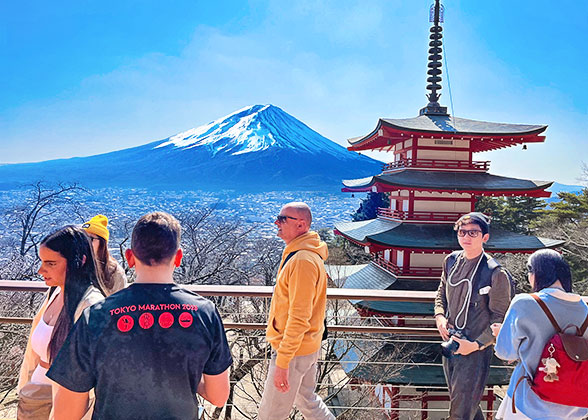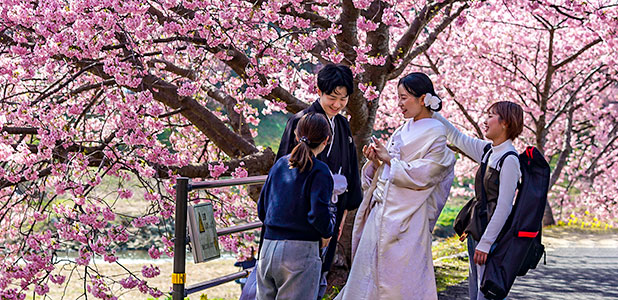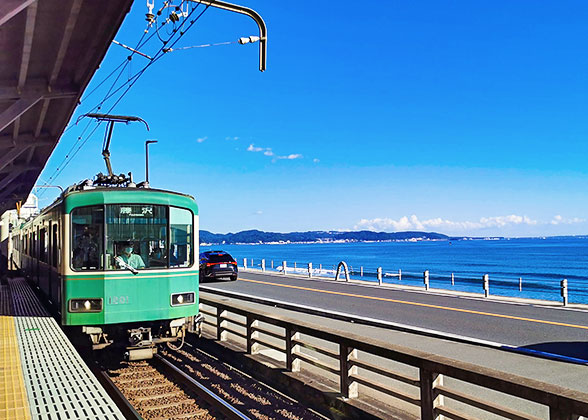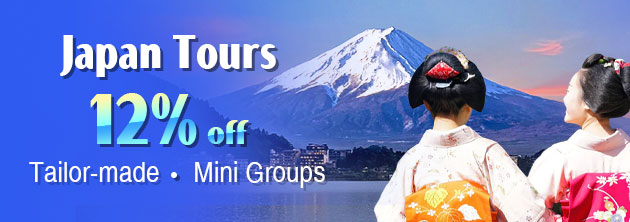- Attractions
- Weather
- Photos
Kamakura Weather
Kamakura,
about 50 km (31 miles) southwest away from Tokyo, enjoys a subtropical monsoon
climate, characterized by distinct seasonal temperature variations. It also has
a rainy season from June to July. It may also be impacted by typhoon in
September and October. Surrounded by mountains on three sides and faces the sea
on one side, the city benefits from abundant oceanic moisture, making it
relatively humid throughout the year.
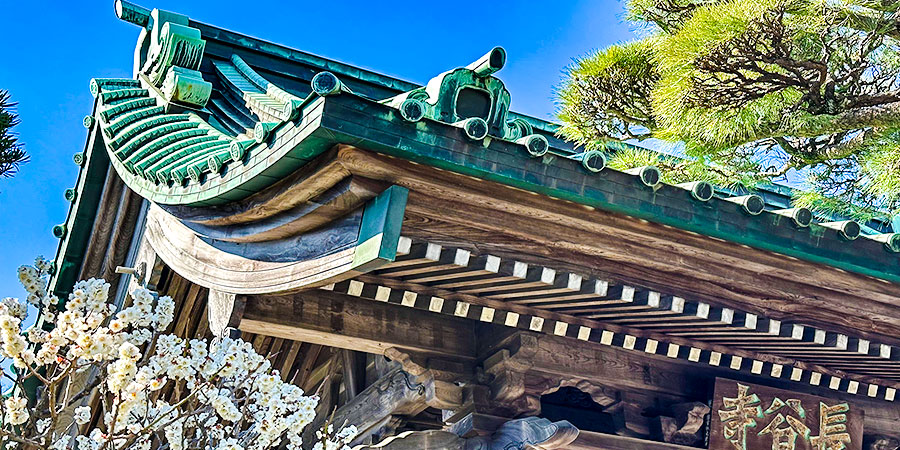
Hasedera Temple on a Sunny Day
|
Distinct Temperature Variations throughout the Year
Kamakura experiences distinct seasonal temperature variations throughout the year, with average temperatures ranging from 2 degrees Celsius (36 degrees Fahrenheit) in winter to 29 degrees Celsius (84 degrees Fahrenheit) in summer. The wide temperature range means it's essential to check the weather forecast before your visit and prepare the appropriate clothing.Hottest Time
Summer from June to August is the hottest period in Kamakura, with average daily high temperature exceeding 26°C (79°F). August is the hottest month of the year, with an average high of 29°C (85°F) and a low of 24°C (76°F). Moreover, when the sun peaks its high, especially in July and August, the heat can be more intense, with the temperature reaching up to 37 degrees Celsius (99 degrees Fahrenheit) due to the strong sunlight. Therefore, be sure to stay hydrated and wear sun protection when visiting Kamakura during this period.Coldest Time
Winter, from December to February, sees a significant drop in temperatures, with an average daily high temperature below 14°C (57°F). However, even during the coldest month, January, temperatures rarely drop below freezing; the average low is 4°C (39°F) and the high is 10°C (50°F).Rainy Season and Typhoon
Influenced by the monsoon weather, Kamakura enters its rainy season in early June. And the rainy season is expected to end in the middle of July in 2026. June is one of the wettest months of the year, with an average rainfall of 180 mm and around 20 wet days. But don’t worry, the rain usually doesn’t last all day, and the weather forecasts are quite accurate. Therefore, it’s always a good idea to check the forecast in advance and pack rain gear. Besides, the rain also helps to cool down the temperatures, so that you can enjoy a cool travel experience thereafter.Kamakura also experiences a typhoon season, with the highest possibilities in September and October. Typhoons generally last for one or two days at a time and bring heavier rainfall than the monsoon-influenced rainy season. Luckily, typhoon tracks are usually predictable, so you can plan and prepare in advance.
For the rest of the year, the rainfall is relatively low, ranging from 60 mm to 130 mm each month. And the rain is mainly light showers, rarely impacting your travel plans. Nonetheless, remember to check the forecast and carry an umbrella in case you need.
Humidity
Kamakura's humidity varies significantly between the rainy and dry seasons. During the dry season, the air is generally dry, with humidity levels hovering around 50% to 60%. However, during its rainy season, particularly in hot summer months like August, visitors might feel muggy and stuffy, with the average humidity reaching around 60%-80%, when it’s recommended to wear quick-dry clothes and stay hydrated.Best Time to Visit Kamakura
The best time to visit Kamakura is spring from March to May and autumn from September to December, as the climate is mild, and moderately humid, making it perfect for outdoor activities. Moreover, in spring, the sakura blossoms in full bloom, adding a romantic charm to many sightseeing spots; in autumn, Kamakura is painted red, offering a stunning view of the maple leaves.
See more about Best Time to Visit Japan & Japan Waether
Kamakura Weather by Month
Kamakura Climate - Seasons & Travel Recommendations
Spring: March to May
Temperatures: 6-21°C (43-70°F)Rainfall: 130 mm -143 mm and 16-17 rainy days per month
Weather Overview: The climate in spring starts to warm up. Early mornings and late evenings can be cool and windy, but the sunshine is abundant during the midday.
Clothes to Wear: Long sleeve shirts or light sweaters and long pants are recommended. It is advisable to bring a light jacket to keep warm on windy days, and in early mornings and evenings. Comfortable sneakers or walking shoes are essential as you might walk a lot.
Seasonal Highlight: You cannot miss sakura blossoms in spring in Kamakura, which add unique charm to the already beautiful sights. For example, visitors can stroll through Tsurugaoka Hachimangu Shrine, enjoying the view of cherry blossoms lining both sides of the path and perfect for photography.

Sakura Blossom
|
Summer: June to August
Temperatures: 20-29°C (68-84°F)Rainfall: 129 mm -180 mm and 18-20 rainy days per month
Weather Overview: Kamakura in summer is hot and humid. Particularly on sunny days, the sunshine can be harsh. Kamakura also enjoys its rainy season during this period. Together with the high temperature, it may make the weather muggy.
Clothes: Thin T-shirts and shorts are necessary to keep cool. Consider wearing a light sun protection jacket and a wide-brimmed hat. Comfortable, breathable sneakers are ideal for long walk, but women can also opt for sandals paired with a skirt for a photo-friendly look.
Seasonal Highlight: In June and July, it's the hydrangea season at Meigetsu-in Temple, which attracts many visitors. To avoid crowds, try to go early in the morning or just before closing time. On weekends, you might need to wait in line for up to an hour.

Summer Days in Kamakura
|
Autumn: September to November
Temperatures: 10-26°C (50-79°F)Rainfall: 98 mm -186mm and 13-18 rainy days per month
Weather Overview: The climate becomes cool in autumn. But the temperature difference between day and night can be significant. When the sun comes out, you probably feel a little hot. Typhoons might occur, resulting in heavy rain.
Clothes: It's advisable to wear light sweaters, jackets, or trench coats. Layering is key, allowing you to easily adjust your clothing as needed. Comfortable sneakers are essential for walking, and women can wear short boots to keep warm and stylish.
Seasonal Highlight: Red maple leaves are the most beautiful views in Kamakura in autumn. Tsurugaoka Hachimangu Shrine, one of the most famous shrines locally, offers fabulous maple leaves view coupled with peaceful Japanese building. Hasedera Temple, a thousand-year-old historic site known for its traditional Japanese garden, hosts a special nighttime lighting event every year during red maple leaves season. The entire garden is illuminated in the evening, offering visitors the chance to enjoy a dreamy night trip in this ancient temple.

Stunning Foliage Scene
|
Winter: December to February
Temperatures: 2-11°C (36-52°F)Rainfall: 64 mm -78 mm and 10-13 wet days per month
Weather Overview: Kamakura’s winter is crisp and chilly, but it can get a bit warm around the noon time of sunny days. Occasional rains occur, but those are usually light showers, rarely impacting your travel plans. But sea winds can be strong.
Clothes: It's best to wear a thick coat plus winter pants. You can layer with a sweater and scarf underneath, and if you feel too warm around noon, you can take off your outer overcoat. For footwear, it's recommended to wear slightly thicker sneakers or comfortable winter boots to stay warm and cozy.
Seasonal Highlight: In winter, the visibility of Mount Fuji is the highest. Without noisy crowds, you can capture stunning photos of Mount Fuji at Shichirigahama Beach on sunny days. Be sure to go in the morning for the best shot, as it can be misty later in the day.

View of Mount Fuji
|


